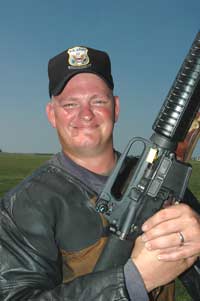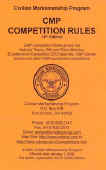
Don’t Be "That Guy"
By SFC Norman Anderson, USAMU Service Rifle Team Member
 |
|
SFC Anderson poses for a picture after winning the 2005 President's Rifle Match. |
You know the guy, he’s still talking at the coffee jug when his preparation
period begins, then his magazines aren’t loaded when the command “Stand”
is given, and finally, he doesn’t know the rules when he argues with the block
officer as his target comes up marked “9 and No.” Although this guy might be
the highlight of the “after match” activities, he is the proverbial bad
apple on the firing line. With this example fresh in your mind, let’s go over
how not to be “that guy”.
The CMP Rulebook is the official rulebook for service rifle and service pistol shooting; governs the conduct of all CMP events in the National Matches and other CMP sanctioned matches.
Now, let’s discuss rules. As you have probably heard more than once, the rulebook is your best friend. Here is why. I can virtually guarantee that most competitors know some of the rules based only on the old “this is how we do it at home” adage. The funny part of that is, the same green NRA rulebook and orange CMP rulebooks are used to govern highpower matches all over the country. It is vital that all shooters be familiar with the rules as they are written, not with “how they are applied at home.” This creates consistency and continuity in how matches are conducted, from local club matches to state tournaments to National Championships. Knowledge is power when it comes to scoring targets under contention, what to do in the case of a malfunction, or even how to file a protest correctly. These rules are in place for a reason and it benefits everyone to both know and operate by these rules.
SFC Anderson
believes being
prepared for a match involves approaching the firing line, knowing what you
are about to do, being ready for what is going to happen (good or bad) and
being ready for the results.
Lastly, I would like to cover preparedness. Being prepared goes beyond simply having your magazines loaded and a zero on your rifle. It means approaching the firing line, knowing what you are about to do, being ready for what is going to happen (good or bad), and being ready for the results. If you approach the firing line to merely shoot 10 shots standing in your next LEG match, you are not going to be pleased with the result. You must be prepared mentally and physically, not only for the next stage, but also the next shot. By being prepared physically (equipment ready), you give yourself peace of mind which is an essential part of being prepared mentally, and by being prepared mentally, you are less likely to become distracted and are more likely to maintain focus for each and every shot.
SFC Anderson shakes hands with his teammate, SGT Brandon Green, after a close finish for the 2005 Creedmoor Cup
Championship.
One aspect of competing that cannot be forgotten is bearing. As I mentioned earlier, you must be prepared for both good and bad to happen. All too often we all see “that guy” (or that “that guy’s” gear) flying off of the firing line in disgust. Remember that we all must maintain our composure and humility in all conditions, not matter what happens. After all, it’s just a game. To put it into perspective, if it were easy, attendance would be a lot higher. Sportsmanship must be displayed in an effort to keep from ruining the day for all those around you. It doesn’t cost anything to smile, and smiling never killed anyone. So turn that frown upside down and keep on marching, better days will come.
The USAMU Service Rifle Team is also answering your
questions pertaining to Service Rifle Shooting including topics such as
Equipment and Ammunition, Shooting Positions and Shooting Techniques and
Tactics. Go to
http://www.odcmp.com/Competitions/USAMU/ShootingTips.htm
to view the latest questions and answers. If you have a question you
would like to ask, email USAMU@odcmp.com.
While the sport of Highpower shooting is a hobby for most, all are passionate
about performance throughout the day. In order to achieve your maximum performance each and every day, it is essential that you conduct yourself as a professional competitor. As a competitor, you have a personal responsibility to know the course of fire as well as the rules and procedures that apply to it and to be prepared to follow them. Knowing this will not only make you a better competitor, but it will enable you to resolve situations with other targets besides your own. So what does all this mean? Follow along to see.
Know the course of fire. It sounds easy enough, as we all shoot plenty of matches, but it’s more than that. If you think about it, how many people in the pits, for example, do not really know what is happening on the firing line? This leads to targets being pulled early during a rapid fire string or missing a shot during a slow fire string. In cases like this, the result is the same, delays in the match and upset competitors. To avoid being “that guy,” it is imperative that you stay tuned to the events as the day progresses. When you are at the range shooting a match, be at the range shooting the match.

The culmination of these efforts results in a shooter that knows how to be ready for success on the range, but also and perhaps more importantly, a shooter who knows what it means to be a competitor. When you have a range full of competitors who know and follow the rules and proper match procedures, the match runs smoothly, everyone shoots well, and a good time is had by all. In the end, isn’t that what it’s all about?